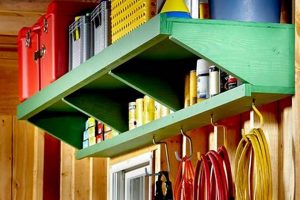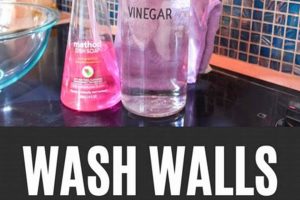A do-it-yourself pallet wall constitutes a decorative and functional interior design element constructed from reclaimed wooden pallets. These structures involve disassembling, preparing, and affixing pallet boards to a wall surface, creating a rustic or textured aesthetic. The final appearance can range from a raw, unfinished look to a carefully sanded and stained finish, depending on the desired effect and the characteristics of the wood.
Employing reclaimed materials for interior design promotes sustainability by repurposing discarded resources. The use of pallets offers an economical alternative to conventional wall coverings and provides a distinctive visual appeal. Historically, the adoption of reclaimed materials reflects a growing awareness of environmental consciousness and a desire to incorporate unique, character-rich elements into residential and commercial spaces. Its popularity also reflects a broader trend toward personalization and cost-effective home improvement solutions.
The subsequent sections will delve into the essential steps for planning, preparing materials, and constructing a pallet wall. Specific attention will be given to safety considerations, surface preparation, design options, and finishing techniques to ensure a successful and aesthetically pleasing outcome.
Tips for a Successful Pallet Wall Installation
The following tips offer guidance for constructing a durable and visually appealing pallet wall, emphasizing precision and safety throughout the process.
Tip 1: Material Selection is Critical: Source pallets that have not been treated with Methyl Bromide (MB), a harmful fumigant. Look for the “HT” stamp indicating heat treatment, which is a safer alternative. Prioritize pallets in good condition, free from excessive damage or rot.
Tip 2: Prioritize Thorough Cleaning and Preparation: Before installation, meticulously clean each pallet board to remove dirt, debris, and any potential contaminants. Sanding the boards ensures a smoother surface and eliminates splinters. This stage significantly impacts the final aesthetic and safety of the wall.
Tip 3: Plan the Layout Meticulously: Before affixing any boards, carefully plan the layout of the wall. Consider the desired pattern, board orientation, and overall design. A well-planned layout minimizes cutting and ensures a cohesive appearance.
Tip 4: Employ Proper Fastening Techniques: Secure the pallet boards to the wall using appropriate fasteners, such as construction adhesive and screws or nails. Ensure that the fasteners are long enough to penetrate the wall studs, providing a secure and stable installation. A stud finder is essential for this step.
Tip 5: Stagger Joints for Structural Integrity: When installing pallet boards, stagger the joints to enhance the structural integrity of the wall. This technique prevents continuous vertical or horizontal seams, distributing stress and minimizing the risk of separation.
Tip 6: Implement Safety Measures: Wear appropriate safety gear throughout the project, including safety glasses, gloves, and a dust mask. Use power tools with caution and adhere to manufacturer’s instructions.
Tip 7: Consider a Sealer or Finish: To protect the pallet wall from moisture and wear, apply a sealant or finish. Choose a product that complements the desired aesthetic, such as a clear sealant to preserve the natural wood or a stain to enhance the color.
By adhering to these guidelines, a durable, aesthetically pleasing, and safe pallet wall installation can be achieved. Careful planning, meticulous preparation, and precise execution are key to a successful project.
The concluding section will explore potential design variations and address common challenges encountered during pallet wall construction.
1. Sustainable Material Sourcing
Sustainable material sourcing forms a foundational pillar in the responsible construction of a do-it-yourself pallet wall. The practice prioritizes the use of reclaimed resources, minimizing the environmental impact associated with deforestation and the production of new building materials. It represents a conscious effort to reduce waste and promote resource conservation within the realm of interior design.
- Minimizing Environmental Impact
Reclaimed pallets, otherwise destined for landfills or incineration, are repurposed, thereby reducing waste generation. This decreases the demand for newly harvested lumber, contributing to forest preservation and mitigating the carbon footprint associated with logging, transportation, and processing. A tangible example is the utilization of discarded shipping pallets from local businesses, diverting them from waste streams and transforming them into functional and aesthetically pleasing wall coverings.
- Resource Conservation
Sourcing used pallets conserves valuable natural resources, including trees, water, and energy. The energy required to process and transport virgin timber is significantly greater than that needed to clean and prepare reclaimed pallets. This approach promotes a circular economy by extending the life cycle of existing materials and reducing the need for resource extraction. Consider the alternative of sourcing sustainably harvested lumber, which, while preferable to conventional logging, still entails resource consumption compared to reusing existing pallets.
- Economic Considerations
Acquiring reclaimed pallets often presents a more cost-effective solution compared to purchasing new lumber or manufactured wall panels. While some preparation may be required, the initial cost savings can be substantial. Furthermore, engaging with local businesses or recycling centers to source pallets supports local economies and promotes community-based resource management.
- Health and Safety Implications
Sustainable sourcing also involves careful consideration of the potential health and safety hazards associated with reclaimed materials. Thorough inspection and cleaning of pallets are crucial to identify and mitigate risks from chemical treatments, contaminants, or pests. Opting for heat-treated (HT) pallets over those treated with Methyl Bromide (MB) ensures a safer and more environmentally responsible approach. This rigorous assessment underscores the importance of informed decision-making in sustainable material sourcing.
In conclusion, the integration of sustainable material sourcing practices into the creation of a pallet wall fosters environmental stewardship, resource conservation, and potentially economic benefits. By prioritizing responsible acquisition and careful assessment, individuals can construct aesthetically pleasing and environmentally conscious interior design elements, furthering the principles of sustainable living and resource management. The conscious selection of reclaimed materials aligns with a growing awareness of environmental responsibility and the desire to minimize ecological impact.
2. Surface Preparation Imperatives
Surface preparation represents a critical determinant in the long-term success and aesthetic outcome of a pallet wall installation. The condition of both the pallet boards and the substrate wall exerts a significant influence on the adhesion, durability, and overall visual appeal of the finished structure. Neglecting proper surface preparation can lead to a multitude of complications, ranging from compromised structural integrity to premature degradation of the installed materials. An example of inadequate preparation is the direct application of untreated pallet boards to a damp wall, which could foster mold growth and subsequent structural failure. Conversely, meticulous cleaning, sanding, and sealing procedures promote optimal bonding and prevent the ingress of moisture and contaminants. The practical significance lies in the transformation of potentially unstable and unsightly materials into a durable and visually captivating feature.
The imperatives of surface preparation extend beyond mere cosmetic improvements; they address fundamental concerns regarding safety and longevity. Removal of splinters, nails, and other potentially hazardous elements from the pallet boards mitigates the risk of injury. Ensuring a level and stable mounting surface for the pallet boards prevents warping, cracking, or detachment over time. Applying a primer or sealant to the substrate wall can enhance adhesion and protect against moisture damage. Consider the case of a pallet wall installed in a high-humidity environment without adequate sealing: the subsequent expansion and contraction of the wood could lead to warping and ultimately necessitate costly repairs. Thus, the investment in thorough surface preparation yields substantial dividends in terms of reduced maintenance and extended lifespan.
In summary, surface preparation constitutes an indispensable phase in the construction of a pallet wall. The implementation of rigorous cleaning, sanding, sealing, and leveling procedures fosters structural integrity, enhances aesthetic appeal, and promotes longevity. Addressing the potential challenges associated with moisture, contaminants, and structural instability ensures a safe and enduring installation. The connection between surface preparation and the successful execution of a pallet wall project underscores the importance of meticulous planning and diligent execution. This foundational stage transforms reclaimed materials into a testament to sustainable design and skilled craftsmanship.
3. Design Aesthetic Options
Design aesthetic options, in the context of a do-it-yourself pallet wall, represent the diverse range of stylistic choices available to customize the wall’s appearance. These options dictate the final visual impact and contribute significantly to the overall ambiance of the space. The selection process requires careful consideration of existing dcor, personal preferences, and the intended functionality of the wall.
- Board Orientation and Pattern
The orientation of pallet boards horizontal, vertical, or diagonal profoundly affects the wall’s visual flow. Horizontal arrangements often convey a sense of expansiveness, while vertical orientations can emphasize height. Various patterns, such as herringbone or chevron, introduce complexity and visual interest. An example involves alternating horizontal and vertical boards to create a dynamic, textured effect, or employing a staggered pattern to mimic the look of traditional wood siding.
- Surface Treatment and Finishing
Surface treatments, including sanding, staining, painting, or whitewashing, alter the inherent character of the wood. Sanding removes rough edges and creates a smoother surface, while staining enhances the wood’s natural grain. Painting offers an opportunity to introduce color and create a more contemporary aesthetic. A common practice involves applying a dark stain to accentuate the rustic texture of the pallet wood, followed by a clear sealant for protection. Alternatively, a distressed paint finish can achieve a vintage or shabby-chic style.
- Color Palette Selection
The choice of color palette exerts a considerable influence on the wall’s overall impact. Neutral tones, such as grays, whites, and browns, provide a versatile backdrop that complements a variety of dcor styles. Bold colors can create a focal point and inject personality into the space. A monochromatic color scheme, using varying shades of a single color, can create a sophisticated and cohesive look. The selection should correlate with adjacent architectural elements to accomplish visual harmony.
- Incorporation of Decorative Elements
Decorative elements, such as lighting fixtures, shelving, or artwork, can be integrated into the pallet wall to enhance its functionality and aesthetic appeal. Strategically placed lighting can accentuate the texture of the wood and create a warm and inviting atmosphere. Shelving provides storage space and allows for the display of decorative objects. The addition of metal accents, such as wrought iron brackets or decorative nails, can further enhance the wall’s rustic charm. These enhancements bring another element to interior decor.
The successful integration of design aesthetic options transforms a simple do-it-yourself pallet wall into a unique and personalized statement piece. By carefully considering board orientation, surface treatment, color palette, and decorative elements, individuals can create a wall that reflects their personal style and enhances the aesthetic quality of their living space. The end result is a testament to individual creativity and resourcefulness, demonstrating the potential of reclaimed materials to create visually stunning and functional design features.
4. Structural Attachment Security
Structural attachment security constitutes a paramount concern in the construction of any do-it-yourself pallet wall. Failure to adequately secure pallet boards to the underlying wall structure can result in detachment, instability, and potential hazard. The connection between the pallet boards and the wall serves as the foundation for the entire installation; therefore, the selection of appropriate fastening methods and adherence to sound construction principles are crucial. An improperly secured pallet board may detach under its own weight or due to minor impacts, presenting a safety risk to occupants. The use of insufficient fasteners or the failure to locate and secure boards to wall studs exemplify common causes of structural failure. In contrast, a well-executed attachment strategy distributes weight evenly and ensures a durable, long-lasting installation.
Practical applications of structural attachment security manifest in several critical areas. Firstly, identifying the location of wall studs is essential for providing a solid anchor point for fasteners. Stud finders are instrumental in this process. Secondly, the selection of appropriate fasteners, such as screws or nails of sufficient length and gauge, is vital for ensuring adequate holding power. Construction adhesive, used in conjunction with mechanical fasteners, can further enhance bond strength. Thirdly, the spacing and pattern of fasteners influence the overall stability of the wall. A greater density of fasteners in areas subject to higher stress or weight loading provides added security. Furthermore, considerations regarding the type of wall material (drywall, plaster, concrete) necessitate the selection of compatible fasteners and installation techniques. For instance, concrete walls require specialized anchors capable of withstanding substantial pull-out forces. A real-world example involves a pallet wall constructed in a commercial setting, where rigorous adherence to building codes and structural integrity standards is mandated to ensure public safety.
In summary, structural attachment security represents a non-negotiable aspect of do-it-yourself pallet wall construction. The employment of sound fastening techniques, coupled with a thorough understanding of wall structure and material properties, is essential for achieving a safe and durable installation. Overlooking this critical element can lead to compromised structural integrity and potential safety hazards. The challenges associated with secure attachment can be mitigated through careful planning, the selection of appropriate materials, and adherence to established construction practices. Recognizing the importance of structural security reinforces the broader theme of responsible and sustainable building practices.
5. Protective Finishing Application
Protective finishing application constitutes a vital stage in the construction of a do-it-yourself pallet wall, designed to enhance its durability, aesthetic appeal, and resistance to environmental factors. This process involves the application of coatings or treatments to the pallet wood, aimed at safeguarding it from moisture, UV radiation, pests, and general wear and tear. Without adequate protection, the longevity and visual integrity of the pallet wall can be significantly compromised.
- Moisture Resistance and Rot Prevention
Finishes such as sealants and varnishes create a barrier against moisture penetration, mitigating the risk of rot, warping, and fungal growth. These coatings prevent water from seeping into the wood fibers, which can lead to structural degradation and unsightly blemishes. An example includes the application of a marine-grade varnish to a pallet wall located in a bathroom or kitchen, where humidity levels are elevated. The implications of neglecting moisture protection include premature deterioration of the wood, necessitating costly repairs or replacements.
- UV Radiation Protection and Color Retention
Exposure to ultraviolet (UV) radiation can cause fading, discoloration, and degradation of wood surfaces over time. Protective finishes containing UV inhibitors shield the wood from these harmful effects, preserving its original color and preventing it from becoming brittle. A clear example is the application of a UV-resistant sealant to a pallet wall exposed to direct sunlight through windows. The consequences of inadequate UV protection include a bleached or weathered appearance, diminishing the aesthetic value of the wall.
- Pest Deterrence and Wood Preservation
Certain finishes incorporate insecticidal or fungicidal properties, which deter pests such as termites, woodworms, and other wood-boring insects. These treatments penetrate the wood fibers, creating a hostile environment for pests and preventing them from infesting the pallet wall. An example involves the application of a borate-based wood preservative to a pallet wall located in a damp or poorly ventilated area. The ramifications of failing to protect against pests include structural damage and potential health hazards associated with insect infestations.
- Enhanced Cleanability and Stain Resistance
Protective finishes create a smooth, non-porous surface that is easier to clean and more resistant to stains. These coatings prevent dirt, grease, and other contaminants from penetrating the wood, allowing for effortless removal with a damp cloth or mild cleaning solution. An example includes the application of a polyurethane coating to a pallet wall in a kitchen or dining area, where food spills are likely to occur. The results of neglecting stain resistance include persistent blemishes and a reduced aesthetic appeal, potentially necessitating frequent cleaning or refinishing.
The integration of protective finishing application into the construction of a do-it-yourself pallet wall represents a proactive measure to ensure its long-term durability, aesthetic appeal, and resistance to environmental factors. By selecting appropriate finishes and applying them meticulously, individuals can safeguard their pallet walls from moisture, UV radiation, pests, and general wear and tear, thereby extending their lifespan and preserving their visual integrity. The consideration of this facet aligns with sustainable building practices. In essence, the investment in protective finishing translates into a more resilient and visually appealing design element.
Frequently Asked Questions
The following questions address common concerns and provide informative answers regarding the construction and maintenance of pallet walls.
Question 1: Are all pallets safe for indoor use in a DIY pallet wall?
No. Pallets treated with Methyl Bromide (MB) are unsafe for indoor use due to the toxicity of the fumigant. Pallets marked with “MB” should be avoided. Opt for heat-treated (HT) pallets as a safer alternative.
Question 2: What are the essential safety precautions during the construction of a pallet wall?
Essential precautions include wearing safety glasses, gloves, and a dust mask. Power tools must be used with caution, adhering to manufacturer instructions. Ensure proper ventilation and a clean workspace.
Question 3: How does one properly clean and prepare pallet boards for a wall installation?
Pallet boards should be thoroughly cleaned with soap and water, followed by disinfection. Sanding is crucial to remove splinters and create a smooth surface. Allow adequate drying time before installation or finishing.
Question 4: What is the best method for attaching pallet boards to a wall to ensure structural integrity?
Locate and mark wall studs using a stud finder. Secure pallet boards to the studs using construction adhesive and screws or nails of appropriate length. Stagger joints for added stability.
Question 5: What type of finish should be applied to a pallet wall, and what are its benefits?
A sealant or varnish is recommended to protect the wood from moisture, UV radiation, and wear. The finish enhances durability, facilitates cleaning, and preserves the aesthetic appeal of the wall.
Question 6: How does one address potential issues related to uneven wall surfaces or board thicknesses?
Uneven wall surfaces can be addressed by shimming behind the pallet boards. Varying board thicknesses can be accommodated by planning the layout to minimize noticeable discrepancies, or by planing thicker boards to achieve uniformity.
Proper material selection, safety measures, preparation, secure attachment, and protective finishing are paramount for a successful pallet wall installation.
The following segment will address advanced design considerations for pallet walls.
Conclusion
This article has comprehensively explored the various facets of the diy pallet wall, from material sourcing and surface preparation to design aesthetics, structural attachment, and protective finishing. Key considerations include the selection of safe and sustainable materials, the implementation of proper construction techniques, and the application of appropriate finishes to ensure durability and longevity.
The successful execution of a pallet wall project demands diligent planning, meticulous execution, and a commitment to safety. A properly constructed pallet wall offers a unique and sustainable design element, contributing to the aesthetic appeal and environmental consciousness of the space. Continued adherence to established best practices will ensure the enduring success of this innovative interior design approach.







